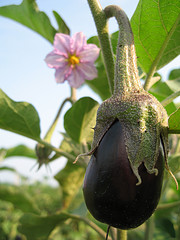Eggplants
| Infobox on Eggplants | |
|---|---|
| Example of Eggplants |  |
| Freshness facts | |
| Optimum carrying temperature | 10°C to 12°C |
| Highest freezing point | -0,8°C |
| Acceptable product temp. at loading into containers | Max. 2°C above carrying temperature |
| Optimum humidity | 90%-95% |
| Ventilation setting for containers | 10 m³/hr |
| Storage life | 2 to 3 weeks |
| Climacteric / non-climacteric | Non-climacteric |
| Ethylene production | Very low |
| Ethylene sensitivity | Medium |
| Modified / controlled atmosphere | 1,5% O2; 1,5% CO2 |
| Potential benefits | Slight |
| Availability | |
| On demand | |
Eggplants
Contents
Harvesting and Handling
Eggplant fruit are harvested at a range of developmental stages. Depending on cultivar and temperature, the time from flowering to harvest may be 10 to 40 days. Generally fruit are harvested immature before seeds begin to significantly enlarge and harden. Firmness and external glossiness are also indicators of a pre-maturity condition. Eggplant fruit become pithy and bitter as they reach an overmature condition.
Harvesting should be done by cutting the calyx-stem free from the plant rather than by tearing. Cotton gloves are often used to protect the fruit. Bruising and compression injury is very common when attention to careful harvest and handling practices are not followed. Eggplant cannot withstand stacking in bulk containers.
Modern standard eggplant quality is primarily based on uniform egg to globular shape, firmness and a dark purple skin colour. Additional quality indices are size, freedom from growth or handling defects, freedom from decay, and a fresh green calyx. Packages commonly are one-piece waxed fibreboard boxes. Fruit are individually wrapped with paper. Wrapping fruits with plastic film to create modified atmosphere reduces weight loss and maintains firmness, due to the high RH.
Cooling and Storage
Rapid (pre-)cooling to 10°C immediately after harvest is necessary to retard discolouration, weight loss, drying of calyx, and decay.
Fruit are stored at 10°C to 12°C with 90% to 95% RH. Storage of eggplant is generally less than 14 days as visual and sensor qualities deteriorate rapidly. Decay is likely to increase after storage >2 weeks, especially after removal to typical retail conditions. Short-term storage or transit temperatures below this range are often used to reduce weight loss, but result in chilling injury after transfer to retail conditions.
Eggplant fruit are chilling sensitive at temperatures below 10°C. At 5°C chilling injury will occur in 6-8 days. Consequences of chilling injury are pitting, surface bronzing, and browning of seeds and pulp tissue. Accelerated decay by Alternaria spp. is common in chilling stressed fruit. Chilling injury is cumulative and may be initiated in the field prior to harvest.
Depending on the soluble solids content, fruit freeze at -0,8°C. Symptoms include water-soaked pulp that becomes brown and desiccated over time.
Controlled atmosphere considerations
CA storage or shipping offers little benefit to eggplant quality maintenance. Low O2 levels (3% to 5%) delay deterioration and the onset of decay only a few days. Eggplant tolerates up to 10% CO2 but storage-life is not extended beyond that under reduced O2.
Storage disorders
Alternaria (Black mould rot), Botrytis (Gray mould rot), Rhizopus (Hairy rot), Phomopsis rot, and Phytophtora (Soft rot).











